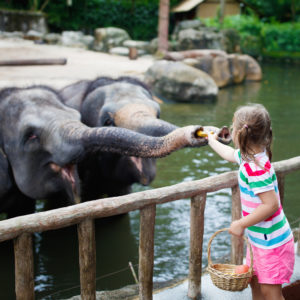With presents unwrapped and the eggnog empty, it’s time to get out of the house and embark on an amazing local adventure. With the kids still home from school and out-of-town relatives lingering, visiting your local zoo is a perfect post-Christmas family activity. All the more so given that December 27th is Visit the Zoo Day.
Zoos offer us the opportunity to interact with majestic creatures that we otherwise would not encounter in our urbanized, day-to-day lives. While National Geographic and Planet Earth do a good job of depicting these animals, nothing matches the indescribable experience of seeing them up close. Zoo lights, which are part of the festive season at many zoos around the country, make the experience even more magical.
Unfortunately, zoos have come under attack in recent years from misguided animal activists who believe animals should never be in human care. In reality, zoos play a vital role in the conservation efforts that these activists claim to support. Most zoos direct a certain part of their revenues to animal conservation efforts. The World Association of Zoos and Aquariums calls on facilities to allocate 3 percent of their budgets to conservation efforts — a threshold that many already meet or surpass. American zoos generate more than $200 million for conservation projects each year.
These conservation efforts often take the form of saving and reintroducing critically endangered species into the wild. The golden lion tamarin, Przewalski’s horse, Puerto Rican parrot, whooping crane, black-footed ferret and California condor are just a few of the more than 100 species that have seen their populations recover as a result of zoos’ captive breeding and reintroduction programs. If it weren’t for zoos, these species likely wouldn’t exist today.
Animal activists overlook these accomplishments and argue that animals should be returned to a “state of nature.” But this argument ignores the fact that no ideal state of nature remains because of human impact on the environment.
Consider tropical rainforests, which are home to 50 percent of the world’s species. Since 1950, more than half of the earth’s tropical rainforests have been destroyed. Not surprisingly, a recent report by the World Wildlife Foundation estimates that animal populations have fallen by 60 percent since 1970.
Animals currently face a multi-front attack from pollution, habitat destruction and climate change. This threat led 15,364 scientists last year to sign a “Warning to Humanity” that humans “have unleashed a mass extinction event, the sixth in roughly 540 million years, wherein many current life forms could be annihilated or at least committed to extinction by the end of this century.”
Already there are only 3,000 tigers, 880 mountain gorillas and 40 Sumatran rhinos left in existence. For such critically endangered animals and those threatened to share their fate, zoos act as arks of hope — oases to protect them from eradication due to human action.
By visiting your local zoo, you’re supporting conservation efforts. You’re also helping deepen the human-animal bond that is a necessary prerequisite for public support of future conservation efforts. There are no better places for children to develop the human-animal bond that will shape them into becoming lifelong conservationists than zoos and aquariums.
In an effort to set the highest animal welfare standards, American Humane certifies facilities — through an independent third-party panel of experts — that are leaders in humane animal care. This distinguishes the best zoos for an increasingly discerning public and gives the rest a clear set of standards to emulate.
Let’s inspire and cultivate future generations of passionate wildlife advocates and conservationists. Take the kids and holiday guests to your local zoo and see for yourselves how to protect the lives of animals both in human care and in the wild. It will be a fun, meaningful adventure together.

